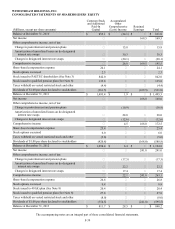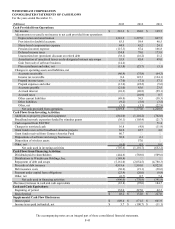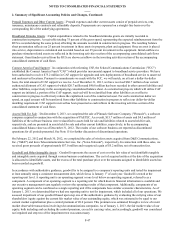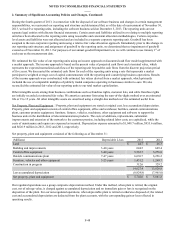Windstream 2013 Annual Report Download - page 182
Download and view the complete annual report
Please find page 182 of the 2013 Windstream annual report below. You can navigate through the pages in the report by either clicking on the pages listed below, or by using the keyword search tool below to find specific information within the annual report.
NOTES TO CONSOLIDATED FINANCIAL STATEMENTS
____
F-46
1. Background and Basis for Presentation, Continued:
There are no significant differences between the consolidated results of operations, financial condition, and cash flows of
Windstream Holdings and those of Windstream Corp. other than for certain expenses incurred directly by Windstream Holdings
principally consisting of audit, legal and board of director fees, Nasdaq listing fees, other shareholder-related costs, income
taxes, common stock activity, and payables from Windstream Corp. to Windstream Holdings. Earnings per share data has not
been presented for Windstream Corp., because following the Holding Company Formation, that entity has not issued publicly
held common stock as defined in accordance with accounting principles generally accepted in the United States ("U.S.
GAAP"). Unless otherwise indicated, the note disclosures included herein pertain to both Windstream Holdings and
Windstream Corp.
Certain prior year amounts have been reclassified to conform to the current year financial statement presentation. These
changes and reclassifications did not impact net income or comprehensive income.
2. Summary of Significant Accounting Policies and Changes:
Significant Accounting Policies
Use of Estimates – The preparation of financial statements, in accordance with U.S. GAAP, requires management to make
estimates and assumptions that affect the reported amounts of assets, liabilities, revenues and expenses and disclosure of
contingent assets and liabilities. The estimates and assumptions used in the accompanying consolidated financial statements are
based upon management’s evaluation of the relevant facts and circumstances as of the date of the consolidated financial
statements. Actual results may differ from the estimates and assumptions used in preparing the accompanying consolidated
financial statements, and such differences could be material.
Business Segments – We are organized based on the services and products that we offer. Our chief operating decision maker
assesses performance and allocates resources based on our consolidated results of operations. Under this organizational and
reporting structure, our operations consist of one reportable segment. See the accompanying consolidated statements of income
for additional information regarding the types of revenue our business generates.
Cash and Cash Equivalents – Cash and cash equivalents consist of highly liquid investments with original maturities of three
months or less.
Restricted Cash – Restricted cash consists of cash restricted for uses other than current operations. We have placed cash into
pledged deposit accounts for our share of committed spend on construction contracts currently under review by the Rural
Utilities Service ("RUS"), part of the United States Department of Agriculture, for broadband stimulus grants. Changes in the
restricted cash balances are reflected as cash inflows or outflows in the investing activities section of the statement of cash
flows. Additionally, in connection with the acquisition of PAETEC Holding Corp. ("PAETEC"), we assumed responsibility for
letter of credit agreements between PAETEC and their financial institution. These letter of credit agreements, which require
cash collateral, relate to contracts entered into by PAETEC in the normal course of business. There was no restricted cash
remaining at December 31, 2013 associated with these letters of credit compared to approximately $1.5 million of restricted
cash at December 31, 2012.
Accounts Receivable – Accounts receivable consist principally of trade receivables from customers and are generally unsecured
and due within 30 days. Expected credit losses related to trade accounts receivable are recorded as an allowance for doubtful
accounts in the consolidated balance sheets. In establishing the allowance for doubtful accounts, we consider a number of
factors, including historical collection experience, aging of the accounts receivable balances, current economic conditions and a
specific customer’s ability to meet its financial obligations. When internal collection efforts on accounts have been exhausted,
the accounts are written off by reducing the allowance for doubtful accounts. Concentration of credit risk with respect to
accounts receivable is limited because a large number of geographically diverse customers make up our customer base. Due to
varying customer billing cycle cut-off, we must estimate service revenues earned but not yet billed at the end of each reporting
period. Included in accounts receivable are unbilled receivables related to communications services and product sales of $46.3
million and $48.5 million at December 31, 2013 and 2012, respectively.
Inventories – Inventories consist of finished goods and are stated at the lower of cost or market value. Cost is determined using
either an average original cost or specific identification method of valuation.
























